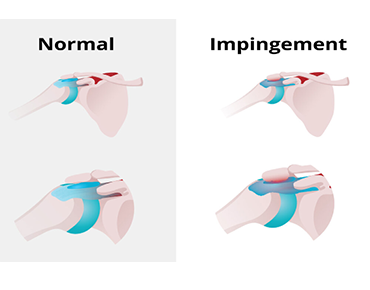Shoulder Impingement
Home / Shoulder Impingement
Shoulder Impingement
Get AppointmentWhat is Shoulder Impingement?
Shoulder impingement is a prevalent cause of pain in the shoulder. It affects the shoulder muscles and tendons, which provide a great range of motion to the arm. Impingement syndrome occurs due to constant rubbing of the tendon and adjacent shoulder bones as the space between them narrows. It can be treated with conservative remedies and by avoiding activities that can cause more pain in the shoulder.
What are the Causes of Shoulder Impingement?
Before delving into the causes, it is necessary to understand the anatomic structures involved in shoulder impingement syndrome.
Rotator Cuff: It is a group of four muscles that emerges from the shoulder blade and attaches as a ‘cuff’ of the tendon onto the humerus (arm bone). It helps in raising and rotating the arm.
Acromion: It is located on the outer edge of the shoulder blade. Impingement occurs when the tendon rubs against the acromion because of space narrowing between them. The space can reduce due to swelling or bone spurs (bony growths near the joint).
Bursa: It is a tiny sac of fluid between the tendon and muscles that gives a slippery motion to the bones and tendons and reduces friction between them.
Other Causes:
- Overuse of the rotator cuff tendon due to repetitive overhead activity
- Inflammation of the bursa due to shoulder injury or overuse
- The acromion is not flat but curved or hooked by birth
- Development of bone spurs with age
What are the Symptoms of Shoulder Impingement?
Impingement in a shoulder hinders the daily life activities of an individual. Normal arm movements such as lifting a bag, extending arms above the head, or even putting on a coat might cause difficulty and pain. Sometimes, the pain is so unbearable that it can affect the patient’s sleep cycle as well.
Symptoms of shoulder impingement syndrome include:
- Weakness or stiffness in the shoulder and/or arm
- Decreased range of motion and strength
- Pain when reaching into a back pocket or zipping up a zipper
- Pain that shifts from the front of the shoulder to the side of the arm
- Difficulty in lying down on the affected side
- Pain while sleeping at night

Diagnosis
Diagnosis of impingement syndrome begins with a medical history and physical exam by your doctor. X-rays will be taken to rule out arthritis and may show changes in the bone that indicate injury of the muscle. Bone spurs or changes in the normal contour of the bone may be present.
Treatments
Non-Surgical Treatment
The doctors would initially try to treat the shoulder impingement syndrome using non-surgical treatment. The recovery time might take several days or a week, but the patients will experience a gradual improvement and return of function of the shoulder. The options recommended by the doctors are:
- Rest:The doctor will suggest rest and limiting activities of the arm that include over the shoulder ones too.
- Non-Steroidal Anti-Inflammatory Medicines:The doctor might prescribe non-steroidal anti-inflammatory medicines to reduce the pain and swelling.
- Physical Therapy:The main focus of a physical therapist will be to restore normal shoulder motion. They might suggest stretching exercises to improve the range of motion. Sometimes, there might be a problem in reaching behind the back; this is caused by the tightness of the inner lining of the shoulder at the back. Specific stretching exercises are recommended to relieve the pain.
Once the pain is relieved, the therapist will recommend exercises to strengthen the rotator cuff muscles. - Steroid Injection:The doctors will go for steroid injections if options like rest, medications, and physical therapy do not relieve the pain. This injection includes a local anaesthetic and a cortisone (an anti-inflammatory medicine) preparation. The injection is administered into the bursa beneath the acromion to relieve the pain.
- Stem Cell Treatment:This involves the extraction of stem cells from an area of higher density and then harvesting them and reinjecting them into the damaged area. The stem cells will transform themselves into the damaged cells and then the healing progresses naturally.
Surgery:
Surgery is advised if the symptoms don’t improve through non-surgical methods.
Arthroscopic shoulder decompression is one method to remove part of the acromion to make more space for the rotator cuff. It is performed to widen the space around your rotator cuff. It is a minimally invasive technique that will require small incisions in the shoulder. In severe cases, open surgery may also be suggested.
Arthroscopic surgery allows the rotator cuff to move freely without causing friction with the other bones. Other problems, such as arthritis in the shoulder or a tear in the rotator cuff, may also require surgical methods for treatment.
GET APPOINTMENT
Schedule Appointment : Your Path to Specialized Care
Get rid of your pain, stress, and enduring with our 24/7 dental services. It's a priority to relieve the pain in surgeon as much as possible. 90% of customers claim that they would come back & recommend us to others.
